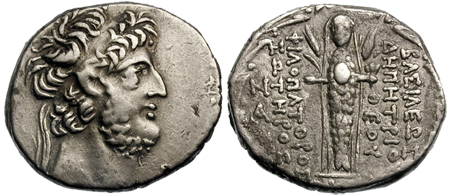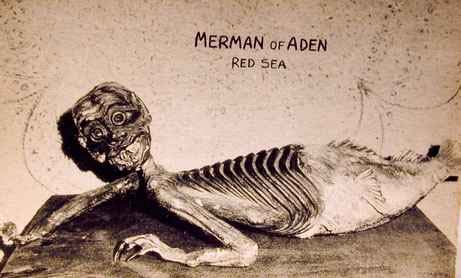Legend and reality about fishmen
Whether the mermaid is real or not is still unknown, but the myths about mermaids are still many. Rumors and evidence of the existence of mermaids make fishmen one of the greatest mysteries of the ocean. Even the name ' fishman ' is also set for an incurable disease.
The legend of fishmen and the truths are discovered
Many past evidence has documented the existence of fishmen. The famous navigators like Christofe Columbo, Ferrnan de Magellan have all recorded trips to meet the ' girl of the sea '.
 The goddess Atargatis in his form fishes on an ancient Greek coin of Demetrius III Eucaerus.
The goddess Atargatis in his form fishes on an ancient Greek coin of Demetrius III Eucaerus.
The fishman is known as a legendary aquatic creature whose upper body is like a girl, white skin, black hair but the lower half is a big tail covered by large scales like fishtail. This image has appeared in the literary literature of many cultures around the world, including the Near East, Africa and Asia. The first stories appeared in the ancient Assyrian literature with the goddess Atargatis turning himself into a fishman for accidentally killing the one he loved. In many other legends, the image of fish is also associated with storms, shipwrecks . but sometimes they also become kind, kind and entangled in love with people.
Many paintings and statues of ancient people also show the image of fish. The mermaids have many similarities to modern humans. They have big, beautiful eyes and look in the same direction as the human eye (the eyes look in two different directions).

(Photo: skeptiseum)
The hand of a fisher has a thumb pointing like a person, convenient for handling labor tools. In the images, the fish have a rather large head compared to the body, indicating that the brain is quite developed. The lower part of the fish is mostly in the shape of a rowing paddle swimming at the end of the tail similar to the whale tail.
Beyond the fictional and fictional framework, we even have stories that are believed to be true by the sailors and coastal residents hundreds of years ago. For the first time the fishers came out of the fanciful stories to be present in front of the naked eye in 1403. The rush of flooding caused the fishermen to be stranded on the Eton coast, Netherlands , then get a group of fishermen people found. According to the book 'Speculum Mundi ' published in 1635 by the British Minister, John Swan, about this event, the beauty of the mermaid appears to soon integrate into the 'earthly' life, likes to wear beautiful clothes, likes to walk Play, listen to the ladies confide, but never will she ever talk half a word.
In 1493, off the coast of Hispaniola , explorer Christopher Columbus saw three mermaids jumping high from the sea. Columbus wrote in his ship diary: 'They are not as picturesque, although to some extent, they have human facial features.' He also noted that he saw similar creatures on the West African coast.

The image of the fish in the reliefs at the Fefiñans Manor and Glacia houses in the 16th century.

The sculptural work by artist James Richards was performed in 1731-1732, which is currently being kept by the National Maritime Museum, Greenwich.
Another encounter with a mermaid was once considered a true story in Edward Snow 's book " The Mystery and the Unbelievable Legend of the Sea ". A captain described his encounter in his 1614 Newfoundland area: "Captain John Smith saw a mermaid swimming close to the impossible to describe. He saw this creature with big eyes, The nose is straight but has short sections and long ears, and Smith said that long blue hair gives a mermaid look " . In front of this beauty, Smith even had a little fluttering look at the woman before suddenly realizing the body under her waist was of fish.

Fish painting by an unknown Russian artist painted in 1866.

Artist's painting Elisabeth Jerichau Baumann drew in 1873
The story of this creature becomes more and more thrilling when the press also comes into play. In 1738, the London daily published a shocking photo: a tiny mermaid discovered on the Hebrides coast , stoned to death because it was mistaken for a monster. Then the ill-fated mermaid was carefully buried, and if anyone had any doubts, any elderly or young person in the village was willing to swear to prove that the story was 100% true.
Today, some museums around the world have stored specimens of mummies . Some scientists claim that fishermen are real, even they think that the cause of marine ecological pollution and the indiscriminate exploitation of aquatic products has made fish become extinct.
The fishman has become a popular topic of movies and novels such as The Fishman 's novel by Russian writer Alexander Beliaev, or The Horror of French writer Guy de Maupassant.
Fishman syndrome
Mermaid Shydrom - Fishman syndrome is a very rare disease in newborns (1 / 70,000 cases). Children born with two legs stick together are very similar to the legendary fish image. Often, children with this disability die immediately after birth for several days due to severe internal organs, kidney failure or other complications.
On November 12, 2006, doctors from Hunan Hospital (China) found a 'fishman' baby placed in front of the hospital gate. This baby is a rare case in medicine: In addition to the conjoined two-leg defect from the thigh to the heel, the baby does not have kidneys, anus and undeveloped external genitalia, intestinal obstruction. . Although using many modern medical interventions such as peritoneal dialysis (peritoneal dialysis), doctors only prolong the life of the patient in a short time.

Baby Milagros Cerron (Photo: giareng)
In the world, there are two surviving ' fishmen ', Tiffany Yorks (17-year-old American, who has had her leg removed successfully as a child). My legs were separated before I was one year old.
The second surviving fish is the baby Milagros Cerron (2-year-old Peruvian, separated from his legs in 2005). Milagros was born in the mountainous city of Huancayo, 200 km east of Lima. Baby Milagros Cerron has two legs attached together like the tail of a fishman.
Milagros's stomach was attached to the leg, she had only one kidney and a common channel for the digestive glands and genitalia.
Doctors at a hospital in Lima successfully performed a leg splitting surgery. The surgical team consists of cardiologists, orthopedic, trauma, neurologists, gynecologists and pediatricians. In the future, baby Milagros will be able to walk and integrate into normal life.
- Virtual reality technology harms health
- 4 wonders intersecting between myths and real life: Imagine fiction that is 100% real
- 8 other applications of virtual reality may appear in the near future
- Legend of Beowulf legend
- You will understand the real fear when wearing virtual reality glasses playing horror games when watching this clip
- How are AR and VR different?
- Fact and fiction about sharks
- Learn how to swim and dive without a shirt thanks to technology
- Samsung's new virtual reality glasses will turn Iron Man's technology into reality
- Google Earth virtual reality lets you tour anywhere in the world
- Virtual reality software exposes brain activity
- Virtual reality device helps women reduce labor pains
 The truth about the mysterious red-haired giant at Lovelock Cave
The truth about the mysterious red-haired giant at Lovelock Cave Inunaki Tunnel: The haunted road leading into Japan's 'village of death'
Inunaki Tunnel: The haunted road leading into Japan's 'village of death' The mystery of the phenomenon of human reflection before dying
The mystery of the phenomenon of human reflection before dying 6 mysterious phenomena, although science has been developed for a long time, still cannot be answered
6 mysterious phenomena, although science has been developed for a long time, still cannot be answered